A guide to the Remembrance Sites of France
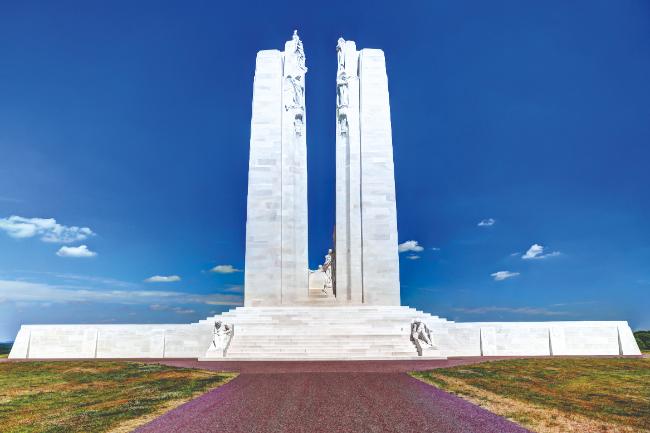
No one could ever accuse the French of failing to remember the vital and tragic role they and their allies played in both the First and Second World Wars. Many regions of this country saw bitter fighting and paid the ultimate price. As citizens of the 21st century, it’s our duty to pay tribute to those who fell protecting Europe between 1914 and 1918 and between 1939 and 1945. Battlefields, cemeteries, museums and remembrance sites all offer poignant reminders of the past.
WORLD WAR II CEMETERIES, MUSEUMS AND MEMORIALS
Wander quietly through the many cemeteries of northern France and reflect on the sacrifice made by the soldiers, many of them tragically young. There are also dozens of museums that remember World War II, the majority focused around the Normandy theatre of war, but plenty in other regions of France that witnessed key military action.
This year, in June, is the 80th anniversary of the D-Day landings, so expect many cemeteries and museums to stage poignant tributes.
Ranville War Cemetery, Ranville, Calvados
This cemetery for Commonwealth soldiers lies 10km northeast of Caen. The village was the first to be liberated following the capture of Pegasus Bridge. Here lie 2,411 identified casualties, mostly British.
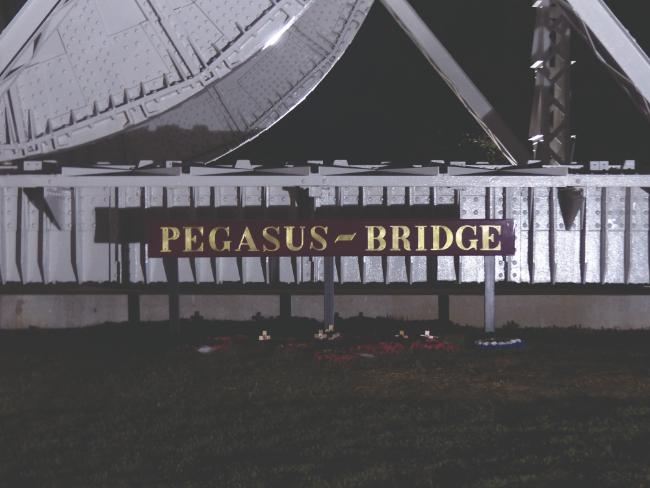
Pegasus Bridge
Bayeux War Cemetery Bayeux, Calvados
This is the largest cemetery in France for Commonwealth casualties from World War II, with over 4,000 graves. Opposite the cemetery is the Bayeux Memorial, bearing the names of more than 1,800 men of the Commonwealth land forces who died in the early stages of the campaign and have no known grave.
Bény-sur-Mer Canadian War Cemetery, Reviers, Calvados
Many of those buried in Beny-sur-Mer Canadian War Cemetery were from the 3rd Canadian Division who died either on D-Day or during the early days of the advance towards Caen. The cemetery contains 2,048 Second World War burials, the majority Canadian, 19 of whom are unidentified.
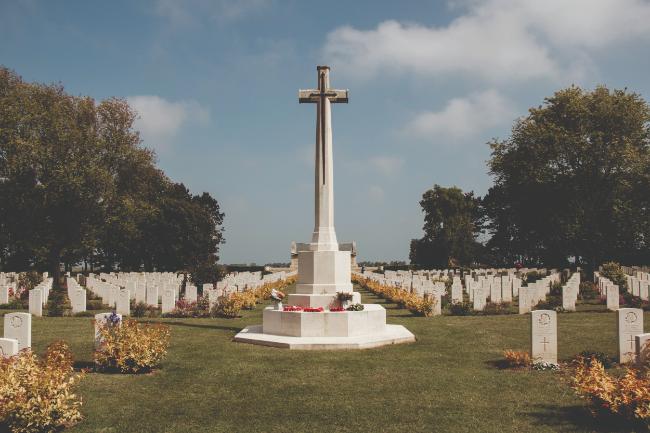
The Canadian military cemetary of Beny-sur-Mer © Severine Freres
Normandy American Cemetery Colleville-sur-Mer, Calvados
On a bluff overlooking Omaha Beach stands this 70-hectare cemetery filled with the graves of 9,380 fallen US soldiers. The memorial consists of a semi-circular colonnade with a loggia at each end containing large maps and narratives of the military operations; at the centre is the bronze statue entitled Spirit of American Youth Rising from the Waves.
Brittany American Cemetery Saint-James, Manche
This site covers 28 acres of countryside in the Manche and contains the remains of 4,410 American war dead. Along the retaining wall of the memorial terrace are inscribed the names of 498 of the missing, while the granite memorial contains a chapel and two large operations maps with military flags overlooking the burial area.
Musée Guerre et Paix en Ardennes, Novion-Porcien, Ardennes
Over the years, the Ardennes’ position close to the border between France, Germany and Belgium means it has featured in many bitter wars. This museum honours the memory of the combatants from the Franco-Prussian War and the two world wars. On show are many vehicles, weapons, uniforms, helmets and civilian objects.
Musée d’Arromanches, Calvados
It was Resistance fighter Raymond Triboulet who came up with the idea for this museum, the first to commemorate the D-Day landings. Now there’s a new building, which opened in 2023, featuring a cinema and exhibitions on the German occupation of Arromanches, the Allied invasion, the battle for Normandy and the key role that the nearby artificial harbour played in it.
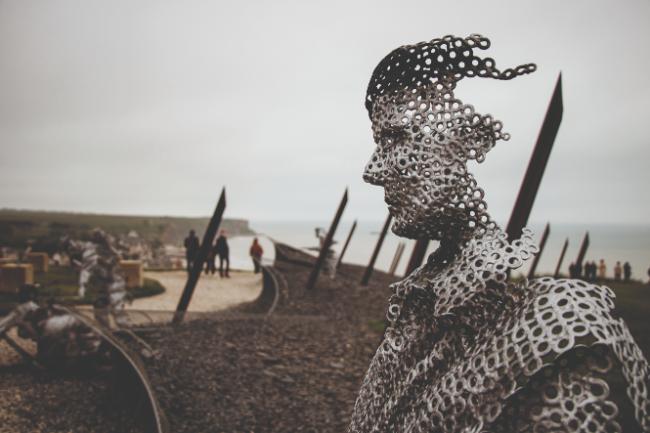
The D-Day garden above Arromanches © Severine Freres
Mémorial Pegasus Ranville, Calvados
Inaugurated in 2000, this museum is dedicated to the heroic actions of Britain’s 6th Airborne Division, the Red Berets, who arrived by glider and parachute to capture bridges across the River Orne and the Caen Canal and to destroy the huge German guns. More than 2,000 men died in the process.

The Airborne Museum
Centre de la mémoire d’Oradour, Oradour-sur-Glane, Haute-Vienne
The village of Oradour-sur-Glane was the site of one of France’s worst World War II atrocities. In 1944, after learning that an SS officer had been held captive here, the Germans brutally killed a total of 643 people, including over 200 children and razed much of the village to the ground. After the war, Charles de Gaulle decided Oradour-sur-Glane should never be rebuilt as a reminder of the cruelty of the occupying army. Today you can visit the Centre de la mémoire d’Oradour, as well as the ruined village itself. Prepare to be deeply moved.
Fort des Dunes, Leffrinckoucke, Nord
This military fort, originally built in the 1870s, played a particularly significant role during World War II. Although much of what happened here was tragic, it’s an intriguing history all the same. During Dunkirk, dozens of French soldiers were killed here in German bombing raids and towards the end of the war, members of the Resistance were executed here by firing squad. Now dedicated to the key episodes in its history, the building features video installations and interactive displays. Open from mid- March until early November, Tuesday to Sunday.
Le Mémorial de Falaise, Calvados
Open from Wednesday to Sunday, this museum is dedicated to the lives of civilians during World War II. Through dramatic film, photography and period exhibits, you will experience all aspects of wartime life in Normandy, ranging from city air raids and German occupation, to the Resistance, the Jewish persecution and the eventual Allied liberation. It all makes for an intriguing and moving visit.
Omaha Beach Memorial Museum, Saint-Laurent-sur-Mer, Calvados
Located on the actual beach itself, this museum recounts in harrowing detail the events of June 6, 1944, through dioramas and an extensive collection of uniforms, vehicles and memorabilia. Open all year except for the months of November, December and January.
Utah Beach Musée du Débarquement, Sainte-Marie-du-Mont, Manche
Utah Beach on the Cotentin Peninsula and the westernmost of the five D-Day landing zones – played a key role in the liberation of Europe, thanks to its proximity to the strategic port of Cherbourg. At this museum, right on the beach, you’ll learn about the German defences, the strategy of the Allies, the naval landings, the air attacks and the land attack. Among the many items you’ll find on show is an original B26 bomber.
Juno Beach Centre, Courseulles-sur-Mer, Calvados
For D-Day, Juno was the name given to the stretch of coastline from Courseulles through to Bernières and Saint-Aubin. The taking of Juno Beach was the responsibility of the Canadian forces and this centre celebrates their heroism. As well as presenting the story of this crucial theatre of war, this museum intimately touches upon the real lives of the 45,000 Canadian soldiers who died, through photographs, film, first-hand accounts and stories passed on through the generations. Guided tours of the beach and the remains of the Atlantic wall courtesy of a Canadian guide – Guided bunker tours are offered from April to October.
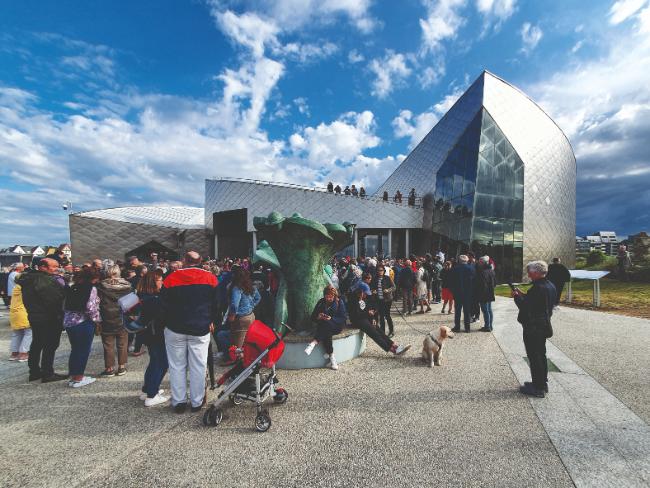
Juno beach centre © Severine Freres
America and Gold Beach Museums Ver-sur-Mer, Calvados
The Gold Beach section of the museum commemorates the historic landings carried out by 69 brigade of 50th Infantry Division on the morning of June 6, 1944. It is closed during the winter.
Musée No.4 Commando Ouistreham, Calvados
This museum, at Sword Beach, tells the amazing story of Philippe Kieffer’s Franco- British commandos who stormed the shore and liberated the port town of Ouistreham on D-Day.

Ouistreham’s Kieffer monument © Marie-Anais Thierry
Le Grand Bunker Ouistreham, Calvados
This museum, housed in a five-storey blockhaus, is dedicated to Normandy’s Atlantic Wall, the system of fortifications constructed by the Germans. Here you’ll discover reconstructed engine rooms, filter rooms, an infirmary, an armoury, a radio transmission room and an observation post equipped with a telescope looking out across the Bay of the Seine.
Overlord Museum Colleville-sur-Mer, Calvados
Situated opposite the Normandy American Cemetery, this museum houses an amazing collection of more than 10,000 items (including uniforms, posters, rare documents and personal objects many found on local battlefields) as well as 40 or so vehicles, tanks and cannons. It was originally compiled by the late Michel Leloup who lived locally and was ten years old when World War II broke out.
Airborne Museum, Sainte-Mère-Église, Manche
This fascinating museum celebrates the great sacrifice made by the American paratroopers of the 82nd and 101st Airborne during D-Day. Poignantly, close to the museum is the belfry on which American parachutist John Steele famously became snagged during landing on June 6, 1944. Despite being taken prisoner by the Germans, he escaped and rejoined his division to fight on. The aeroplanes on display include a Waco glider and a Piper Cub Grasshopper.
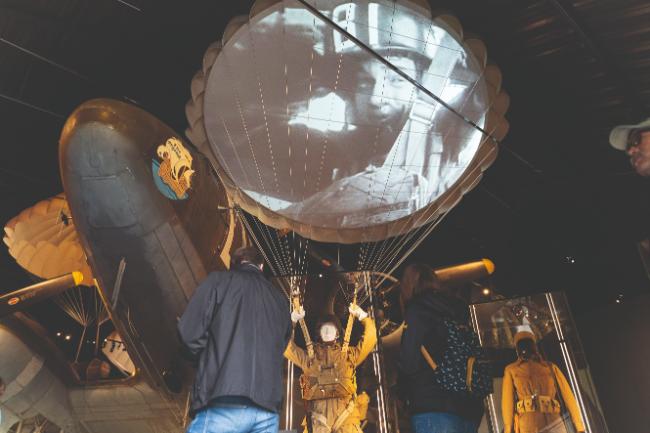
Airborne Museum © Danielle Dumas
Musée Mémorial de Bloody Gulch Méautis, Manche
This area saw ferocious fighting between German and 101st Airborne US soldiers – in what became known as the Battle of Bloody Gulch and many relics remained buried in the ground or hidden in homes for over 65 years. Now visitors can discover what was left by the soldiers and hear the testimony of civilians who survived the battle.
D-Day Experience Saint-Côme-du-Mont, Manche
Discover both the German and Allied perspectives on D-Day at this 10,000m² site with two museums, a memorial and a 3D cinema that shows an award- winning documentary, D-Day Normandy 1944. It’s stirring stuff, all right.
Le Mémorial de Caen, Caen, Calvados
This museum and the adjacent gardens cover many aspects of World War II, with special focus on the events in Caen and its surrounding area. There’s also a section on the Cold War.
Le Mémorial de Falaise, Falaise, Calvados
Unlike many of the other museums featured here, this one shifts the focus firmly onto the role civilians played during World War II and their unflagging courage through incessant bombings and the stranglehold of Nazism.
D-Day Wings Museum, Bretteville-sur-Odon, Calvados
This aeronautical museum, housed inside the old aircraft hangars at Carpiquet aerodrome, focuses on the aeroplanes and pilots of World War II. This was one of the air bases from which German planes took off to fight in the Battle of Britain. There’s even the chance to sit inside some of the cockpits.
Musée Dunkerque 1940, Dunkirk, Nord
This museum celebrates Operation Dynamo, as it was codenamed, when more than 338,000 soldiers fled from to Dunkirk to England in the space of just nine days in the evacuation of 1940. You’ll see a rich collection of weapons, uniforms, models, photos and maps of military operations.
Musée Mémoire 39-45 Calais, Pas-de-Calais
Located inside a bunker that was used by the German army for telecommunications, this fascinating museum features collections of newspapers, propaganda posters, weapons and uniforms.
WORLD WAR I CEMETERIES, MUSEUMS AND MEMORIALS
Northern France was also the focal point of much of the fighting during the First World War, with the Western Front running close to the country’s borders with Belgium, Luxembourg and Germany. A century on, there are no survivors left to tell the tale, but the cemeteries, museums and memorials remain as poignant as ever.
Cemetery tours Arras, Pas-de-Calais
Designed especially for Australians, Sacred Ground Tours, based in the town of Arras, offers tours around the First World War sites of northern France to the areas where Australian soldiers made their most notable wartime contributions.
The Sir John Monash Centre, Fouilloy, Somme
Through a series of interactive media installations, this museum, in the grounds of the Villers-Bretonneux Military Cemetery, tells the story of the huge sacrifice made by Australian servicemen on the Western Front all in the words of those who served.

The Villers-Bretonneux cemetery © Lisa-Michele Burns
Musée de la Grande Guerre, Meaux, Seine-et-Marne
It claims to be Europes largest museum dedicated to the First World War. Built on the site of the first Battle of the Marne, the 3,000m² building houses 70,000 or so items and documents pertaining to everyday military life. Many of the exhibits once belonged to passionate historian Jean- Pierre Verney, who spent much of his life gathering them together, before selling his collection to the museum. The venue is closed between August 15 and September 1.

Musée de la Grande Guerre in Meaux
Historial de la Grande Guerre Péronne and Thiepval, Somme
Two sister museums comprise this visitor attraction split between the Somme towns of Péronne and Thiepval. The former, which you enter through a 13th-century castle, explores the “full cultural, social and military scale” of the Great War. The latter, close to the imposing Thiepval Memorial, is dedicated to the fighting of the Somme, especially the Somme Campaign of 1916.
Le Centre d’Interprétation Vignacourt 14-18, Vignacourt, Somme
During the First World War, keen photographers Louis and Antoinette Thuillier took more than 4,000 glass plate photographs of soldiers and civilians, all of which gathered dust in the farm attic for almost a century before being discovered and put on display at this museum.
Musée du Fort de la Pompelle Puisieulx, Marne
Constructed in the wake of the Franco-Prussian War, Fort de la Pompelle was of vital importance to the defence of Reims in the First World War and came under heavy bombardment from the German offensive of 1914. In the 1950s, it was converted into a museum. Displaying artillery equipment and troops’ living quarters, the museum’s chief attraction is its impressive collection of 560 helmets and caps worn by the various regiments of the German Imperial Army.
Memorial de Verdun, Verdun, Meuse
Located in the hills around Verdun, still pockmarked from the millions of shells which killed more than 300,000 soldiers here, the Verdun Memorial Museum retraces the history of the most famous French battle in the First World War through its displays of weaponry, medical equipment, photographs and recreated trenches.
Citadelle Souterraine Verdun, Verdun, Meuse
Augmented reality headsets really bring this visitor attraction to life in the underground galleries of the town’s citadel where, on foot and aboard battery-powered carriages, you can find out what life was like for French soldiers during World War I.
Musée de la Bataille de Fromelles, Fromelles, Nord
Inaugurated in 2014, this museum honours the 250 or so British and Australian soldiers who were buried in a mass grave near Fromelles, in the Nord department. The building, designed by architect David Serero, is inspired by the German military blockhouses dotted along the local beaches. To celebrate this year’s Rugby World Cup, which is being held in France, there’s a temporary exhibition (until the end of January) called ‘Au Coup de Sifflet!” (“‘Blow the Whistle!”), dedicated to the history of rugby during the First World War.
Musée Jean et Denise Letaille Bullecourt 1917, Bullecourt,
Pas-de-Calais Jean and Denise Letaille spent a lifetime collecting various military objects from the fields around Bullecourt. The resulting museum – in – the couple’s former barn – presents the very personal stories behind the two Battles of Arras, one from World War I, the other from World War II.
www.arraspaysdartois.com/en/ remembrance/visit-bullecourt-1917-museum
Musée Somme 1916 Albert, Somme
The Battle of the Somme cost one million lives. Heading down into the subterranean Musée Somme 1916 is a sobering experience, only emphasised by the dark alcoves and trenches. The museum works exceptionally well as an educational day out: families can follow in the mud-laden footsteps of the soldiers themselves, observe recreated scenes and pore over the collection of helmets, uniforms and weapons before embarking on the Remembrance Trail.
Mémorial de l’Armistice Compiègne, Oise
In a railway carriage, in a clearing in the Compiègne Forest, the Allies and the Germans signed the armistice on November 11, 1918, which finally brought an end to the First World War. Twenty-two years later in June 1940, Hitler, bent on revenge, chose exactly the same place to force the French to sign their surrender. Now, the original railway carriage forms the focal point of this intriguing museum, which is not far north of Paris.
Carrière Wellington Arras, Pas-de-Calais
Descending the lift shaft into the Wellington Quarry, beneath the town of Arras, you get a real sense of just how grim and sombre it must have been for the Allied soldiers who excavated these tunnels in the effort to defeat the Germans during the Great War. The majority of them were New Zealanders, but they were joined by miners from Britain, too. Together they extended and linked up the old limestone quarries to create over 10 miles of tunnels which snaked their way from the main town all the way underneath no man’s land, as far as the German front line. Now modern-day visitors can descend into the tunnels too.
Vimy Memorial Vimy, Pas-de-Calais
On the opening day of the Battle of Arras, in April 1917, the four divisions of the Canadian Corps, fighting side by side for the first time, captured the tactical 60m-high Vimy Ridge. After the war, it was on this ridge that the Vimy Memorial was built, a tribute to all Canadians who fought during the First World War and particularly to the 60,000 who gave their lives in France. The monument, designed by W.S. Allward, was unveiled by King Edward VIII in 1936.
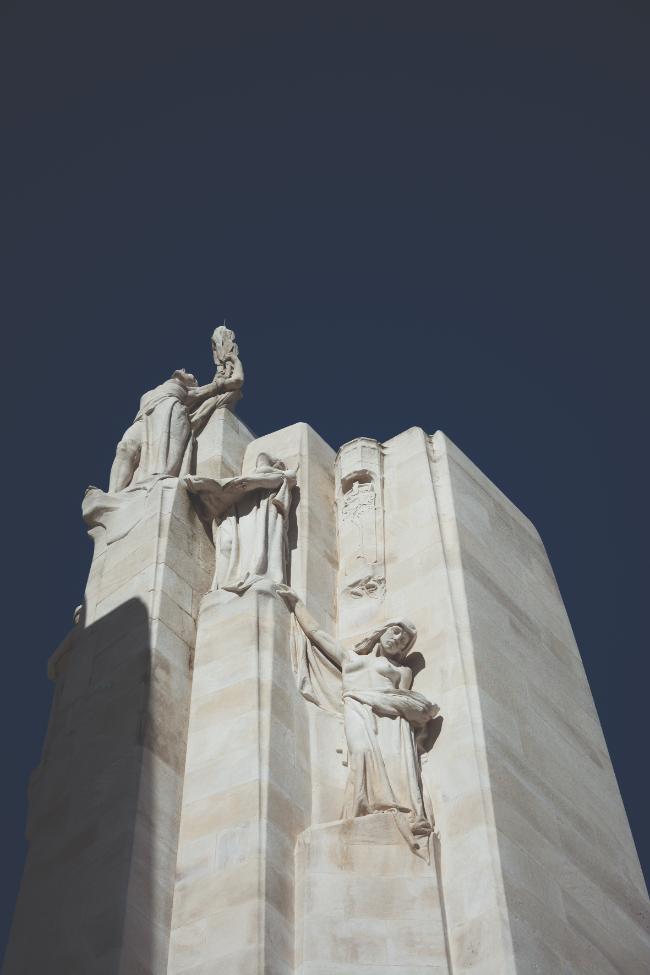
The Vimy memorial © Shutterstock
Fort Douaumont Verdun, Meuse
This is the tallest of the 19 forts built following the Franco-Prussian War to protect Verdun from attacks. With accompanying barracks, the building was constantly modernised and fortified in the years leading up to 1914. Plaques commemorate those who tragically lost their lives here and tell the fascinating story of the fort’s capture, as well as its later recapture by French troops.
Memorial 14-18 Ablain-Saint-Nazaire, Pas-de-Calais
This is the largest necropolis in France, containing the remains of more than 42,000 French soldiers, with a beautiful basilica and memorial buildings. There is also the Anneau de la Mémoire (Remembrance Ring), a vast, modern-day sculptural memorial engraved with the names of nearly 600,000 soldiers who died.
Mémorial Dormans, Dormans, Marne
Standing on top of a hill in the ggrounds of Château de Dormans, this is the principal monument to the soldiers who were killed in the two Battles of the Marne, and more than 19,000 visitors come here each year. Built in 1919, with a 52m steeple and a long staircase leading to its entrance, the chapel offers views over the Marne valley.
Aisne-Marne American Cemetery, Belleau, Aisne
At the foot of Belleau Wood, this cemetery contains the graves of well over 2,000 US soldiers who fought in the Marne Valley in the summer of 1918. The memorial chapel sits on a hillside, decorated with sculptured and stained- glass details of wartime personnel, equipment and insignia. Inscribed on its interior wall are 1,060 names of the missing. It’s a deeply moving memorial.
Lead photo credit : The Vimy memorial © Shutterstock
Share to: Facebook Twitter LinkedIn Email
More in history, memorials, remembrance, war sites in France
Leave a reply
Your email address will not be published. Required fields are marked *



